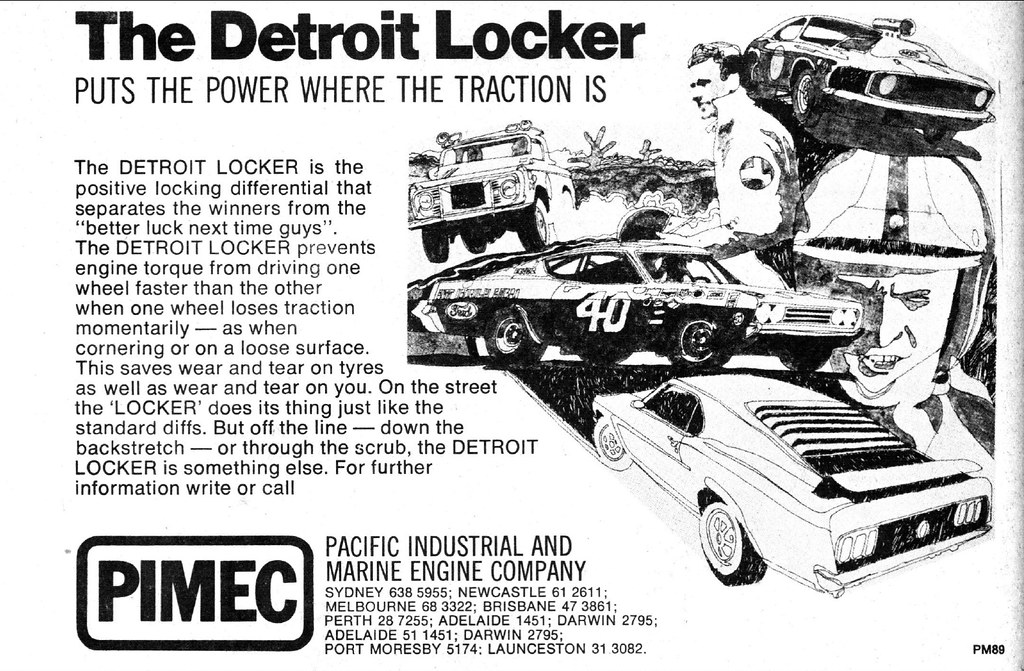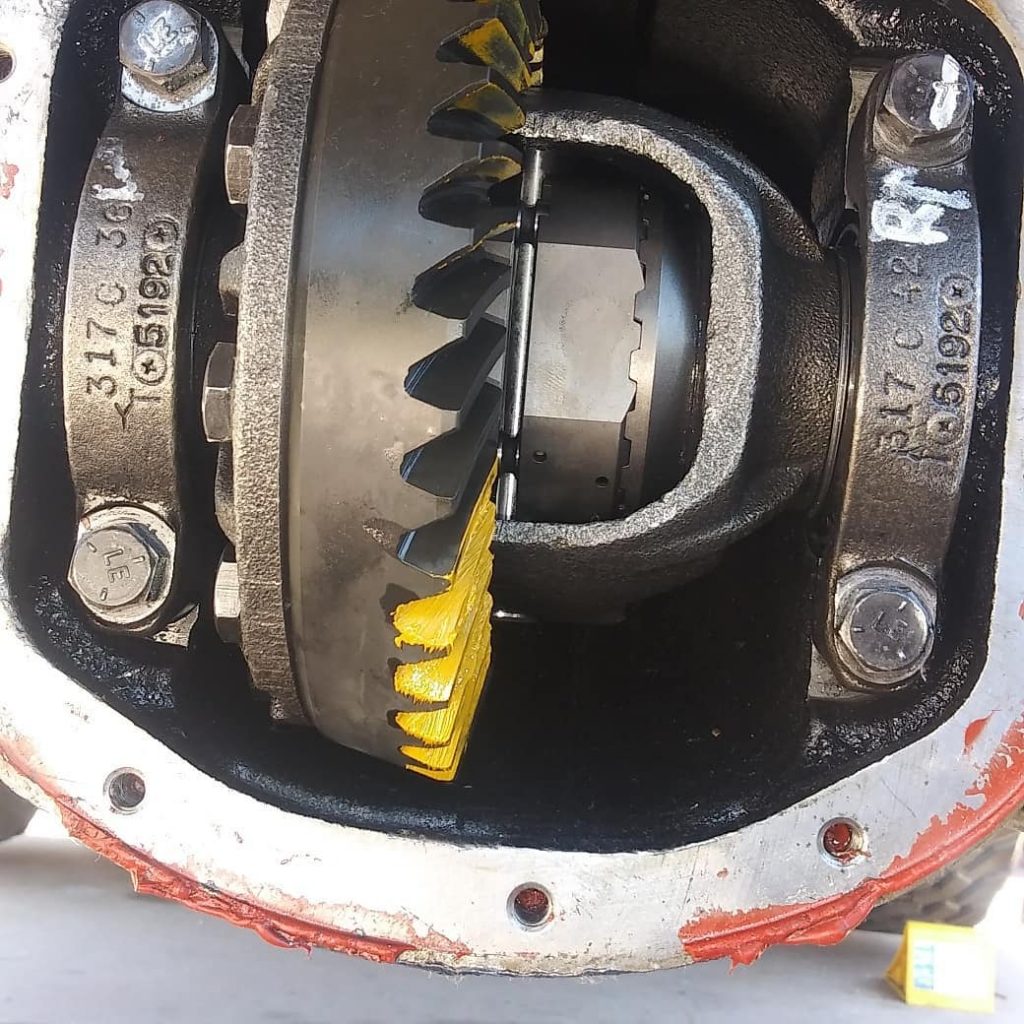How does a differential work?
Before we get into what a locking differential does, let’s take a look at the purpose of differentials in general.
Imagine for a minute that you have a go-kart and only one of the rear wheels is connected to the motor. You’re cruising along and spot a baby bog ahead that only a mudder could love. You give ‘er and the next thing you know you’re snookered like a deer in a sinkhole. Your drive wheel is stuck in the mud. Guess what? Your go-kart won’t go. Some go-karts overcome this differential dilemma by using a solid axle which allows both drive wheels to turn at the same time. This too has drawbacks though. When you make a turn, the wheel on the outside of the turn needs to spin faster, as it has more distance to cover. A solid axle will not allow that to happen. This means turning can be difficult, the inside wheel can hop around a bit, and your tires will wear quicker than a politician’s promises.

The modern differential is a mechanical messiah. It allows both tires to receive power and travel at different speeds. It does this through the use of a spider gear. If one wheel is not moving as fast as the other, such as the case during a turn, the spider gear will spin around its axis. This allows it to continue providing full power to the faster wheel so you’re driving along and one wheel slips in mud, the other will still have some torque to keep the car moving forward.
What is a wheel locker/ locking differential?
As in life, there are limits to the standard differential. If you are driving along a relatively stable piece of road and hit a patch of mud, there’s generally no problem. If you’re a hard-core wheeler indulging in some epic off-roading though, you may be tracking your threads through some mega mud. You may even find yourself in a position where one of the rear tires is off of the ground (a sign of an awesome day if there ever was one!). The standard differential provides power to the wheel with the least resistance. If one tire is in the air, or in a patch of mud deeper than a puddle, then that tire will spin freely. This will cause the spider gear to spin about its axis in the direction of the least resistance, meaning your airborne tire is spinning like crazy and your firmly-planted-on-the-ground tire is sitting there like an ex-president i.e. with little to no power.

A locking differential, also called a wheel locker, will cause your axle to behave similarly to the solid axle go-kart described earlier. Mirroring you and your wife when you did your first dance at your wedding, both wheels will be in perfect sync -turning at the exact same speed regardless of the traction that they have. This means that when you hit that long relentless patch of mud or one of your tires gets airborne, the other one will keep on spinning, and keep your Jeep moving forward.
Just like if you were dating the sister of an identical twin, it’s important to point out the difference between a locking differential and another type of differential you may have heard of, the limited-slip differential. Limited slip differentials are designed mostly for pavement purveyors. In examples like our baby-bog patch of mud, limited-slip differentials will limit the slippage allowed by the spider gear and let some power still get to the other tire. Because they still allow some slippage, they are less ideal for our off-road example because the tire on the ground will not be getting as much power as it would with a locking differential.
What types of locking differential are there?
The two main types of locking differential are the ones that activate automatically and those that must be activated manually. The automatic locking differential, known as the Detroit Locker, is one of the most popular choices. Detroit Lockers will lock the differential any time torque is applied to the vehicle. Like non-alcoholic beer, this can take some getting used to as accelerating while in a turn will cause the lockers to lock up and alter the way the vehicle handles. Other types of automatic lockers might wait until they detect wheelspin before they lock up. Whichever style you use, you don’t have to be Bryce Menzies to get the hang of driving with an automatic locker, it’s fairly easy, and it’s convenient to have the increased traction whenever it’s needed.

If you can’t picture yourself taking advantage of locked wheels all that often, or just want full control over when it happens, then manually activated lockers might be a better choice for you. By using manual lockers, you can cut down on unnecessary tire and drivetrain wear that can occur from the wheels being locked when it is not necessary. You can also ensure a consistent driving experience so that you don’t need to get used to the handling quirks that an automatic setup brings with it.
Ultimately, there is no right or wrong style, so don’t sweat the call. Your choice between an automatic or a manual locker will depend on how often you plan to use it and what is available to you.
When do you use it?
As we’ve mentioned, there are several reasons why you would not want to use a locking differential for day to day trips around town. However, because of their ability to provide traction, they are considered as vital as a mudder’s change of clothes if you’re seeking serious off-road performance. If you limit your off-road excursions to the type of dirt roads that you might drive a sedan down (seriously, dude?), then you will find limited use for a locking differential– a limited-slip differential is all you need. If your excursions are a little more adventurous, however, then locking the differential will provide a significant boost to your off-road performance, adrenaline level and fun factor..
It would also be worth turning on the locking differentials if the trail isn’t particularly rough, but is snowy or very muddy. In both of these instances, the additional traction and reduction in choice curse words gained by eliminating tire slip could prove to be well worth it. Remember, engaging them will have an effect on your turning ability so be mindful of the tradeoffs you are making.

You may also find that locking the differential will provide some much-needed traction if you have to pull a four-wheeler from the mud after your buddy let his ego do the driving. For general towing on the street, you will more than likely want to stay away from locking your wheels because traction generally isn’t a problem on asphalt and the benefits will not outweigh the downsides.
Bear in mind that if you have equipped your Jeep with an automatic locking differential, then you won’t have to worry about when to engage it and when not to.
How do I get one?
If you have decided that a locking differential is something that would benefit your driving style and have not purchased a Jeep yet, then you should consider buying a Jeep Rubicon. Locking differentials for both the front wheels and the rear wheels are standard on the Rubicon rig, the only Jeep to offer this. The locking differentials on the Rubicon are of the manual type, which means that you will be responsible for turning them on and off.
If your Jeep does not have locking differentials standard, then you will need to purchase an aftermarket differentials and have them installed. They are a very common aftermarket upgrade so your favorite aftermarket parts retailer should have them. If you are not familiar with aftermarket parts, then your favorite mechanic’s shop will be able to order and install them for you.










